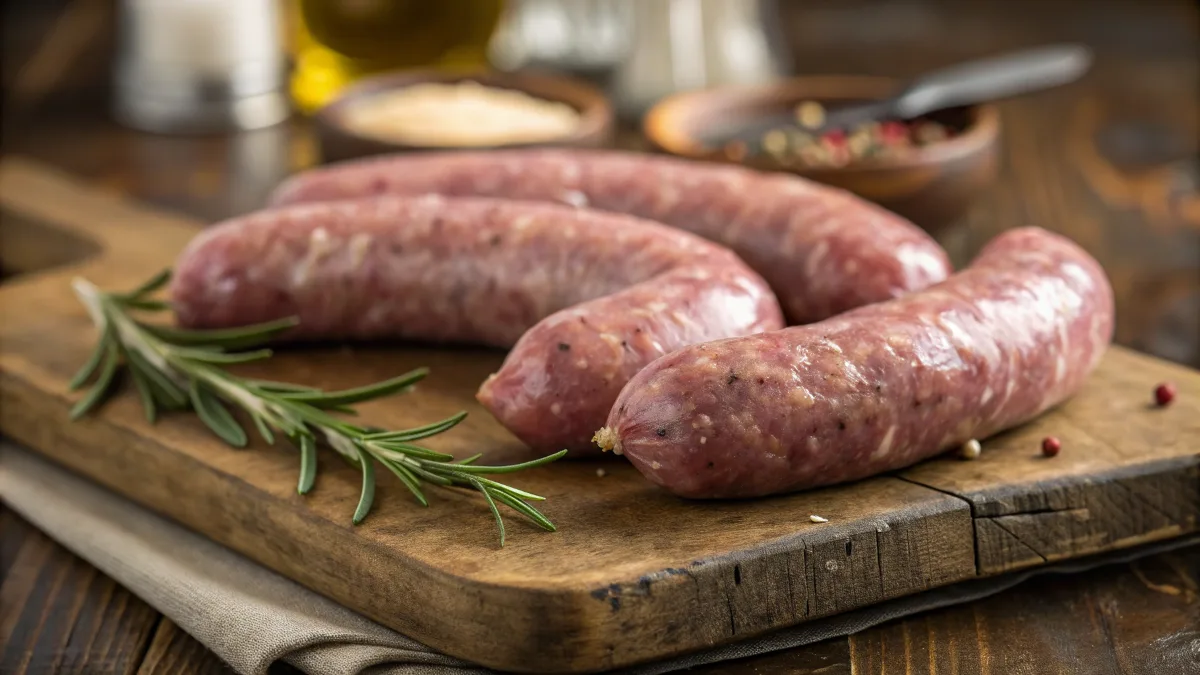Venison sausage is a flavorful, protein-rich alternative to traditional pork or beef sausage, offering a leaner and more distinctive taste. Whether you’re a hunter with a freezer full of venison or simply looking to try something new, making your own sausage at home allows you to control the ingredients and flavors. The key to a juicy, well-balanced venison sausage lies in the right fat ratio, seasoning, and proper cooking methods. From selecting the best spices to achieving the perfect smoky finish, this guide will walk you through everything you need to know to create tender, delicious venison sausage at home.
Introduction to Venison Sausage
What is Venison Sausage?
Venison sausage is a type of sausage made from deer meat, often blended with pork fat to improve its texture and juiciness. Unlike traditional sausages made from pork or beef, venison sausage has a distinct, rich flavor and is significantly leaner. Hunters and wild game enthusiasts have been making venison sausage for generations, using a variety of seasonings and preparation methods to enhance its natural taste.
Venison is classified as a red meat, but it differs from beef or lamb in terms of fat content and texture. Because deer are free-range animals that graze on natural vegetation, their meat tends to be more nutrient-dense and lower in fat. This makes venison sausage a healthier alternative to conventional store-bought sausages, which often contain preservatives and fillers.
Why is Venison Sausage Popular?
Venison sausage is beloved for several reasons. First, it provides a way to enjoy wild game meat in a familiar and versatile form. Unlike venison steaks or roasts, which require careful cooking to avoid dryness, sausage can be prepared in various ways—grilled, smoked, pan-fried, or baked—while retaining moisture and flavor.
Another reason for its popularity is the control over ingredients. When making venison sausage at home, you can choose your preferred fat content, seasonings, and smoking techniques. This customization allows for a healthier, preservative-free sausage that aligns with individual tastes and dietary preferences.
Additionally, venison sausage is a great way to make use of trimmings from a deer that might not be suitable for other cuts. By grinding and seasoning these parts, nothing goes to waste, making it a sustainable choice for those who hunt.
The Unique Taste and Texture of Venison Sausage
The flavor of venison sausage is what truly sets it apart. It has a deep, slightly sweet, and earthy taste due to the deer’s natural diet of herbs, nuts, and berries. Compared to beef or pork sausage, venison has a firmer texture and a richer umami profile.
However, because venison is so lean, it needs added fat to improve its texture and juiciness. The type of fat used—whether pork fat, beef fat, or even butter—affects the final flavor. Proper seasoning also plays a significant role in enhancing the taste while balancing out any gamey notes.
For those looking to explore different variations, deer sausage offers a unique way to enjoy wild game in a traditional form.
Health Benefits of Venison Sausage
Is Venison Sausage Good for You?
Yes, venison sausage can be a healthier alternative to traditional sausages when made with the right ingredients. Since venison is naturally lean, it contains less saturated fat and cholesterol than beef or pork. This makes it an excellent choice for those looking to reduce their intake of unhealthy fats while still enjoying a protein-rich diet.
Another benefit of venison is that it’s free from antibiotics and hormones, unlike many commercially raised meats. Because deer are wild animals, their meat is as natural and organic as it gets.
If you’re interested in a healthier alternative for morning meals, check out this venison breakfast sausage recipe for a lean, protein-packed start to the day.
Venison vs. Beef: Which is Healthier?
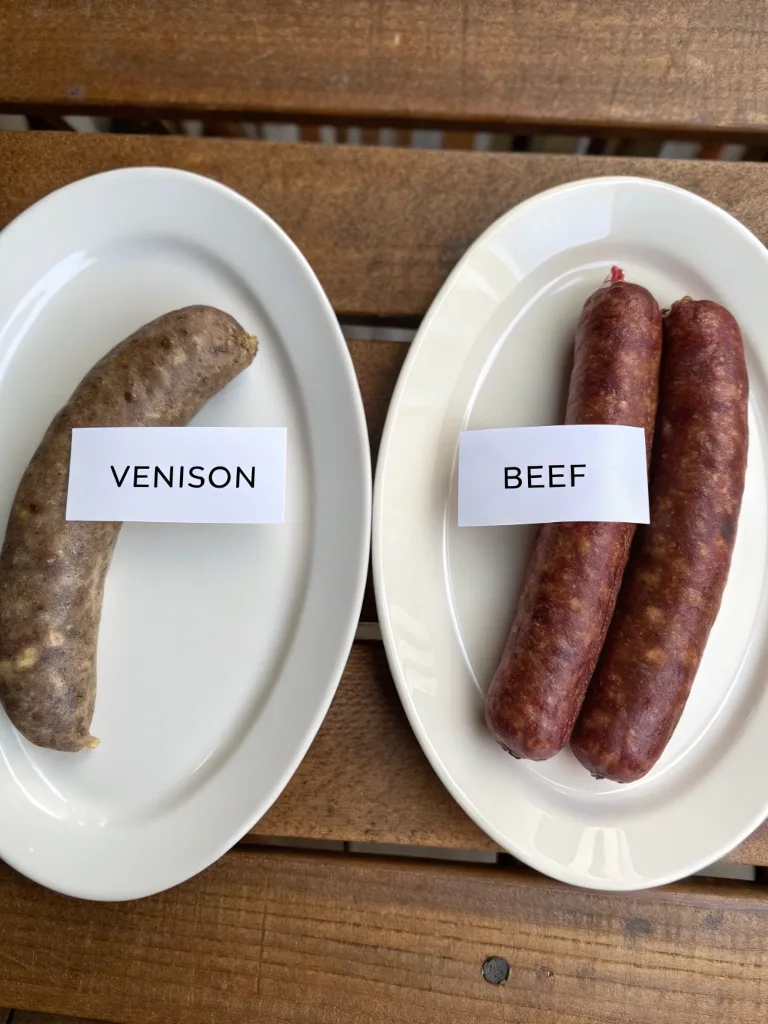
To understand how venison sausage compares to beef sausage, let’s take a look at their nutritional differences:
| Nutrient | Venison (Per 100g) | Beef (Per 100g) |
|---|---|---|
| Calories | 158 | 250 |
| Protein | 26g | 22g |
| Fat | 3g | 17g |
| Saturated Fat | 1g | 7g |
| Cholesterol | 66mg | 73mg |
As seen in the table, venison is lower in calories and fat while being higher in protein. This makes it a great choice for those looking to maintain a lean diet without sacrificing taste.
Nutritional Breakdown of Venison Sausage
The nutrition of venison sausage depends on the added fat and seasonings. A homemade venison sausage using lean deer meat and a moderate amount of pork fat (20-30%) will be much healthier than store-bought options that often contain fillers and preservatives.
Choosing the Right Meat and Fat Ratio
Why Does Venison Need Added Fat?
Venison is incredibly lean, which means it lacks the natural fat needed to keep sausage moist and tender. Without added fat, the sausage can become dry, crumbly, and tough. The right amount of fat ensures a juicy texture and better mouthfeel while helping carry the flavors of the seasonings.
Best Fat Sources to Mix with Venison
When making venison sausage, the most common fat sources include:
| Fat Type | Flavor Profile | Best Usage |
|---|---|---|
| Pork Fatback | Mild, creamy | Smooth texture, neutral flavor |
| Pork Shoulder | Rich, slightly sweet | Enhances juiciness, adds flavor |
| Beef Suet | Beefy, firm | Adds a strong meaty taste |
| Butter | Buttery, light | Works for specialty sausages |
Pork fatback is the most popular choice because it blends seamlessly with venison, enhancing texture without overpowering the natural flavor.
Ideal Venison-to-Fat Ratio for the Perfect Sausage
The fat ratio depends on personal preference, but the general recommendations are:
| Fat Ratio | Best For |
|---|---|
| 80% venison / 20% fat | Leaner sausage |
| 70% venison / 30% fat | Balanced texture |
| 60% venison / 40% fat | Juicier sausage |
For those who prefer extra moist and rich sausage, 30-40% fat works best.
Seasoning and Flavoring Your Venison Sausages
Essential Spices
Seasoning is crucial in venison sausage to balance the gamey flavor. Essential spices include:
- Salt – Enhances natural meat flavors
- Black Pepper – Adds mild heat and depth
- Garlic Powder – Boosts umami
- Onion Powder – Adds slight sweetness
- Paprika – Contributes color and mild spice
Traditional vs. Modern Seasoning Blends
Traditional venison sausage often includes sage, thyme, and marjoram, while modern versions experiment with cumin, coriander, or even maple syrup for a sweet-savory balance.
Tips for Balancing Flavors
- Use acidic elements like vinegar to cut gamey flavors
- Add a touch of sweetness (brown sugar, honey) for depth
- Blend fresh herbs for a more aromatic taste
How to Make Venison Sausage at Home
Step-by-Step Guide to Grinding and Mixing
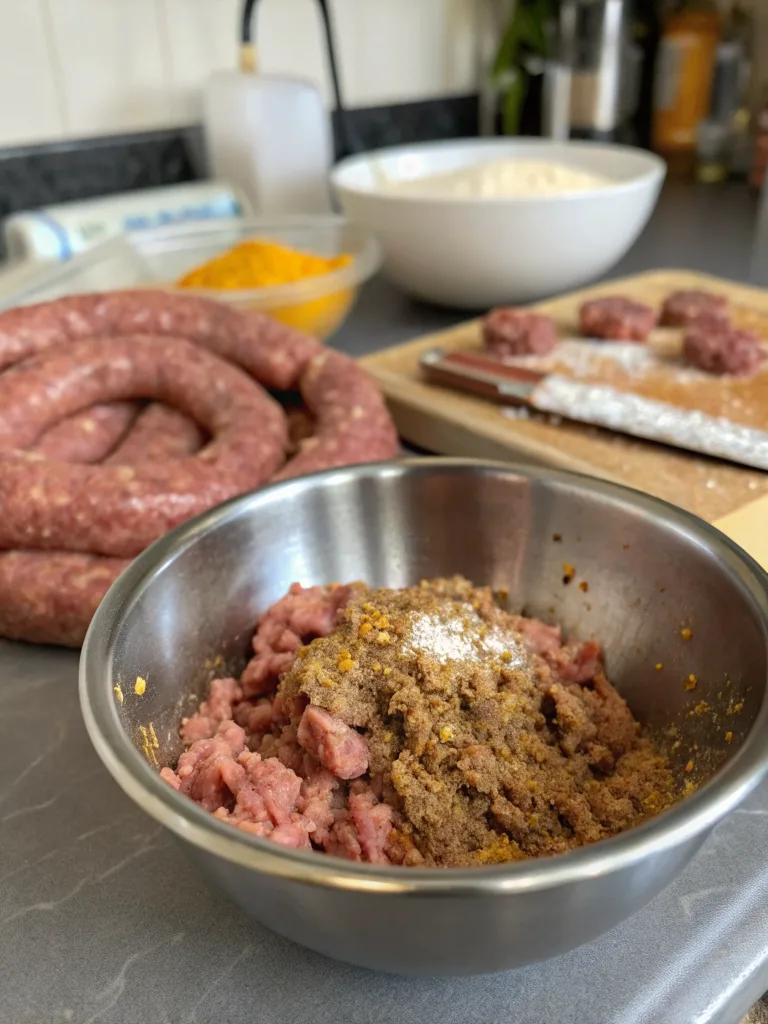
- Chill the meat and fat – Cold ingredients grind better
- Grind using a coarse plate – Ensures the right texture
- Season evenly – Mix spices thoroughly before stuffing
Stuffing Sausage into Casings
- Use natural hog casings for best results
- Fill casings firmly but not too tight to avoid bursting
- Prick air pockets with a needle to prevent splitting
Tips for Avoiding Dry or Tough Sausage
- Keep everything cold to retain fat distribution
- Don’t overwork the meat mixture
- Add a little water or broth for extra moisture
Cooking Methods
How Do You Cook Venison Sausage?
Cooking sausage properly ensures that it remains juicy, flavorful, and tender. Since venison is leaner than pork or beef, it requires careful preparation to prevent it from drying out. There are multiple ways to cook venison sausage, each offering a unique texture and flavor profile. The most common methods include:
- Pan-frying – Quick and easy for crispy, golden-brown sausages
- Grilling – Adds smoky flavor with a slight char
- Baking – Evenly cooks sausages while retaining moisture
- Smoking – Enhances the natural flavors with a deep, smoky aroma
Pan-Frying vs. Grilling vs. Baking

Each cooking method has its benefits depending on the texture and flavor you’re aiming for.
| Cooking Method | Benefits | Best Practices |
|---|---|---|
| Pan-Frying | Quick, crispy exterior | Use a little oil to prevent sticking and cook on medium heat |
| Grilling | Smoky flavor, slightly charred | Cook over indirect heat first, then sear at high heat to finish |
| Baking | Even cooking, retains moisture | Bake at 350°F (175°C) for 25-30 minutes, turning occasionally |
| Smoking | Deep flavor, juicy texture | Slow smoke at 200-225°F (93-107°C) for 2-3 hours |
Pairing your venison sausage with a complete breakfast? Try this breakfast with sausage recipe for a delicious morning meal.
Best Temperature and Time for Cooking
Venison sausage should be cooked to an internal temperature of 160°F (71°C) for safe consumption. Using a meat thermometer ensures it’s thoroughly cooked without drying out.
To avoid overcooking:
- Use medium heat when pan-frying
- Grill over indirect heat first, then finish with a sear
- Bake with a small amount of broth or butter to retain moisture
How to Smoke Venison Sausage for Maximum Flavor
Best Wood for Smoking Sausage
Smoking sausage enhances its flavor, adding depth and richness. The type of wood used plays a crucial role in the final taste.
| Wood Type | Flavor Profile | Best Pairings |
|---|---|---|
| Hickory | Strong, bold | Classic smoky venison sausage |
| Applewood | Mild, slightly sweet | Pairs well with sage and thyme seasoning |
| Mesquite | Intense, earthy | Ideal for spicy sausages |
| Cherry | Sweet, fruity | Works with maple-flavored venison sausage |
Step-by-Step Smoking Process
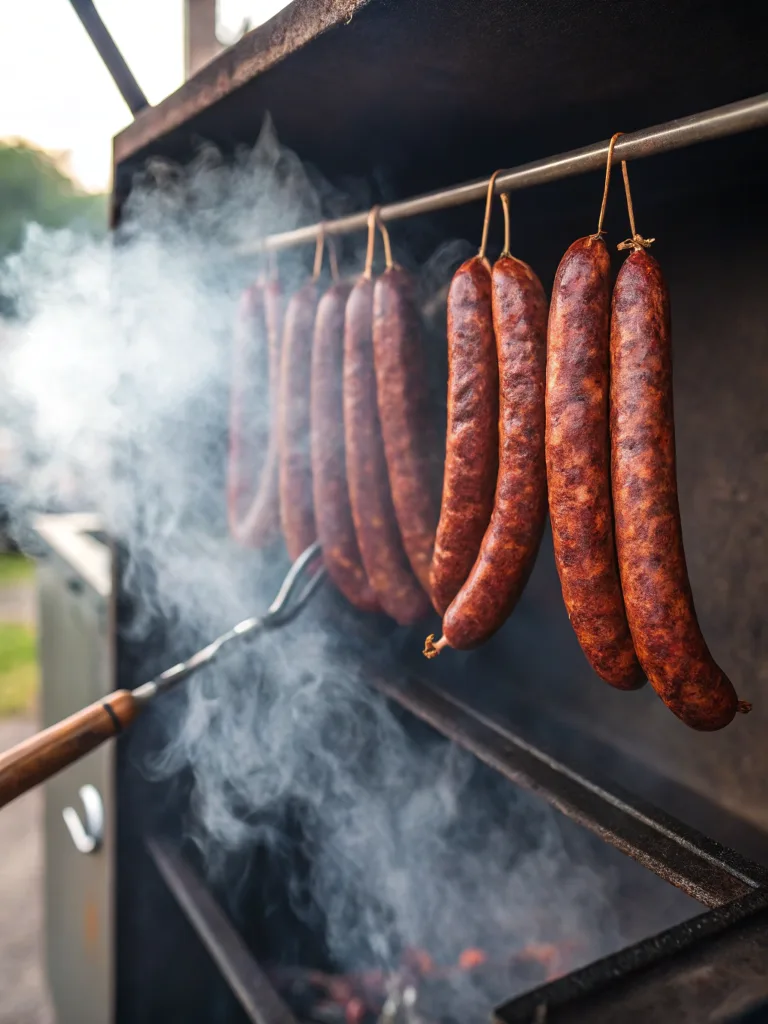
- Prepare the smoker – Preheat to 200-225°F (93-107°C).
- Add wood chips – Soak them in water for 30 minutes before use.
- Hang or place sausages on racks – Avoid overcrowding to ensure even smoking.
- Smoke for 2-3 hours – Keep an eye on the internal temperature.
- Rest before serving – Let sausages rest for 10 minutes to allow juices to redistribute.
For those who enjoy store-bought flavors but want a homemade twist, this Jimmy Dean breakfast sausage recipe is a great inspiration for seasoning your venison sausage.
How to Prevent Venison Sausage from Drying Out
- Use a water pan in the smoker to maintain humidity.
- Smoke at low heat for slow, even cooking.
- Avoid over-smoking, as too much exposure can lead to bitterness.
Storage and Shelf Life Sausage
Freezing vs. Refrigerating Sausage
Proper storage ensures your venison sausage stays fresh and flavorful.
| Storage Method | Shelf Life | Best Practices |
|---|---|---|
| Refrigeration | 3-4 days | Store in an airtight container |
| Freezing (Raw Sausage) | 3-4 months | Vacuum-seal for best results |
| Freezing (Cooked Sausage) | 2-3 months | Wrap tightly in plastic wrap and foil |
If you’re looking for more creative ways to use your leftovers, try incorporating venison sausage into sourdough discard breakfast recipes for a unique and hearty meal.
How Long Does Venison Sausage Last?
Fresh venison sausage should be consumed within three to four days when refrigerated. If frozen, it can last up to four months without losing quality. Proper sealing and storage prevent freezer burn and maintain texture.
Signs of Spoilage and Food Safety Tips
To ensure safety, check for these signs of spoilage before consuming venison sausage:
- Off-putting odor – A sour or rotten smell indicates spoilage.
- Slimy texture – A sticky or slippery surface suggests bacterial growth.
- Color changes – If the sausage turns grayish or green, discard it immediately.
For best safety practices:
- Thaw sausages in the refrigerator, not at room temperature.
- Cook sausages within 24 hours of thawing for optimal freshness.
Frequently Asked Questions
Is Venison Sausage Good for You?
Yes, venison sausage can be a healthier option compared to traditional pork or beef sausages. Since venison is naturally lean and lower in saturated fat, it’s a great choice for those watching their cholesterol or trying to eat cleaner. Additionally, wild venison is free from antibiotics and hormones, making it a more natural protein source. However, the health benefits depend on the fat and ingredients added to the sausage. If you use lean cuts, moderate fat, and natural seasonings, venison sausage can be both delicious and nutritious.
How Do You Cook Venison Sausages?
Venison sausages can be cooked in several ways, including grilling, pan-frying, baking, or smoking. The key to keeping them juicy and tender is to cook them slowly at medium heat to prevent the lean meat from drying out. Unlike pork sausage, which has higher fat content, venison sausage requires a bit more attention. Cooking tips include:
Pan-frying over medium heat for about 10-12 minutes, turning frequently.
Grilling over indirect heat first, then searing for a crispy texture.
Baking at 350°F (175°C) for 25-30 minutes in a covered dish with a little broth.
Smoking at 200-225°F (93-107°C) for 2-3 hours for maximum flavor.
Is Venison Beef or Pork?
Venison is neither beef nor pork—it comes from deer. It is classified as red meat, similar to beef, but it has a leaner texture and a milder, slightly gamey taste. Because venison is naturally low in fat, it is often mixed with pork fat when making sausage to improve its texture and moisture level.
Why is Venison Not Sold in Stores?
Unlike beef and pork, venison is not mass-produced or farm-raised in the same way. Since most venison comes from wild deer, strict food safety regulations make it difficult to sell in grocery stores. The USDA requires that meat sold commercially be inspected and processed in regulated facilities, but wild deer hunting does not allow for such controlled conditions. Some specialty butcher shops or online retailers offer farm-raised venison, but it is much less common than beef or pork.
Is Venison Sausage Considered Processed Meat?
Yes, venison sausage is a processed meat, since it undergoes grinding, seasoning, and sometimes curing or smoking. However, the level of processing depends on how it is made. Store-bought sausages often contain preservatives, nitrates, and fillers, while homemade venison sausage can be much healthier when made with natural ingredients and minimal additives.
For those interested in other rich, smoky meats, you might also enjoy this Texas brisket bacon recipe, which brings a deep, savory flavor similar to smoked venison sausage.
What is Another Name for Deer Sausage?
Venison sausage is sometimes called wild game sausage, hunter’s sausage, or simply deer sausage. Depending on the seasoning and preparation, it may also be labeled as:
Venison bratwurst – German-style sausage with traditional spices.
Venison summer sausage – Cured and smoked for longer shelf life.
Venison chorizo – Spicy, paprika-seasoned sausage inspired by Spanish and Mexican flavors.
No matter the name, venison sausage remains a favorite among those who appreciate lean, flavorful wild game meats.
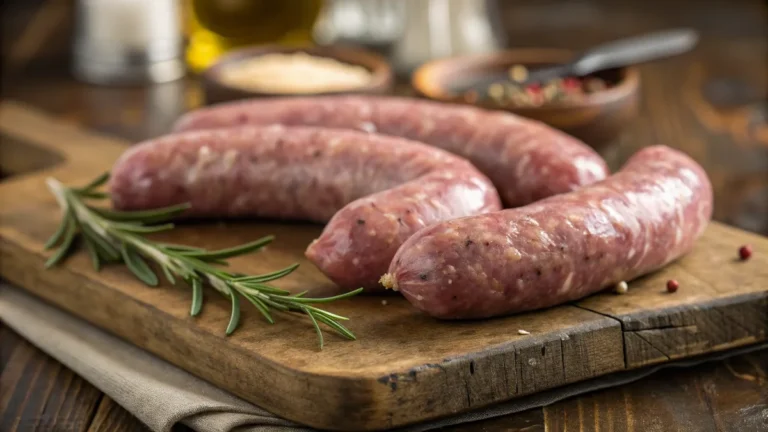
Venison Sausage: How To Make It Tender And Smoky
A complete guide to making delicious, juicy venison sausage at home, from selecting the right fat ratio to seasoning and cooking techniques.
- Total Time: 1 hour 5 minutes
- Yield: 8 servings 1x
Ingredients
- 5 lbs venison (trimmed and cubed)
- 2 lbs pork fatback
- 2 tbsp salt
- 1 tbsp black pepper
- 1 tbsp garlic powder
- 1 tbsp onion powder
- 2 tsp paprika
- 1 tsp thyme
- 1 tsp sage
- 1 cup cold water
- Natural hog casings
Instructions
- Chill the venison and pork fat in the freezer for 30 minutes before grinding.
- Grind the venison and fatback together using a coarse grinder plate.
- In a large mixing bowl, combine the ground meat with all seasonings and cold water.
- Mix thoroughly until well combined.
- Soak natural hog casings in warm water for 30 minutes, then rinse.
- Load the sausage stuffer and carefully fill the casings without overstuffing.
- Twist into links and prick air bubbles with a needle.
- Refrigerate overnight for flavors to meld.
- Cook by grilling, pan-frying, baking, or smoking until internal temperature reaches 160°F (71°C).
Notes
For a juicier sausage, use a 70% venison to 30% fat ratio. Store in the refrigerator for up to 4 days or freeze for longer storage.
- Prep Time: 45 minutes
- Cook Time: 20 minutes
- Category: Sausage
- Method: Smoking, Grilling, or Pan-Frying
- Cuisine: American
Nutrition
- Serving Size: 1 sausage link
- Calories: 220
- Sugar: 0g
- Sodium: 580mg
- Fat: 15g
- Saturated Fat: 6g
- Unsaturated Fat: 8g
- Trans Fat: 0g
- Carbohydrates: 1g
- Fiber: 0g
- Protein: 18g
- Cholesterol: 55mg
Keywords: venison, sausage, wild game, homemade sausage, smoked sausage
All nutritional values and baking times are approximate and may vary based on ingredients, equipment, and altitude. Please adjust as needed.
Conclusion
Venison sausage is a delicious, healthy, and versatile alternative to traditional sausages. Whether you enjoy it grilled, pan-fried, or smoked, its rich flavor and lean profile make it a favorite among hunters and wild game enthusiasts. By mastering the right fat ratio, seasoning blends, and cooking techniques, you can create tender, juicy venison sausage at home that surpasses anything store-bought.
If you’re new to making venison sausage, start with classic seasonings like garlic, black pepper, and sage before experimenting with bolder flavors like mesquite smoke or spicy chorizo blends. Don’t forget to store it properly and cook it to 160°F (71°C) for the best results.
Making your own venison sausage is more than just a cooking process—it’s a way to honor the hunt, reduce food waste, and enjoy a natural, wholesome meal. Whether you’re a seasoned hunter or a first-time cook, this guide has equipped you with everything you need to make perfect venison sausage every time.
Table of Contents
1️⃣ Love experimenting with wild game recipes? Follow us on Facebook for more delicious venison dishes, cooking tips, and kitchen inspiration!
2️⃣ Looking for creative ways to cook venison? Check out our latest recipe boards on Pinterest and pin your favorite venison sausage ideas!
3️⃣ Join the conversation on Twitter and share your homemade venison sausage creations with us! We’d love to see your results and hear your best cooking tips.
4️⃣ Want another great take on homemade venison sausage? Read this amazing guide on Homegrown Hopes for more insights and step-by-step instructions!

